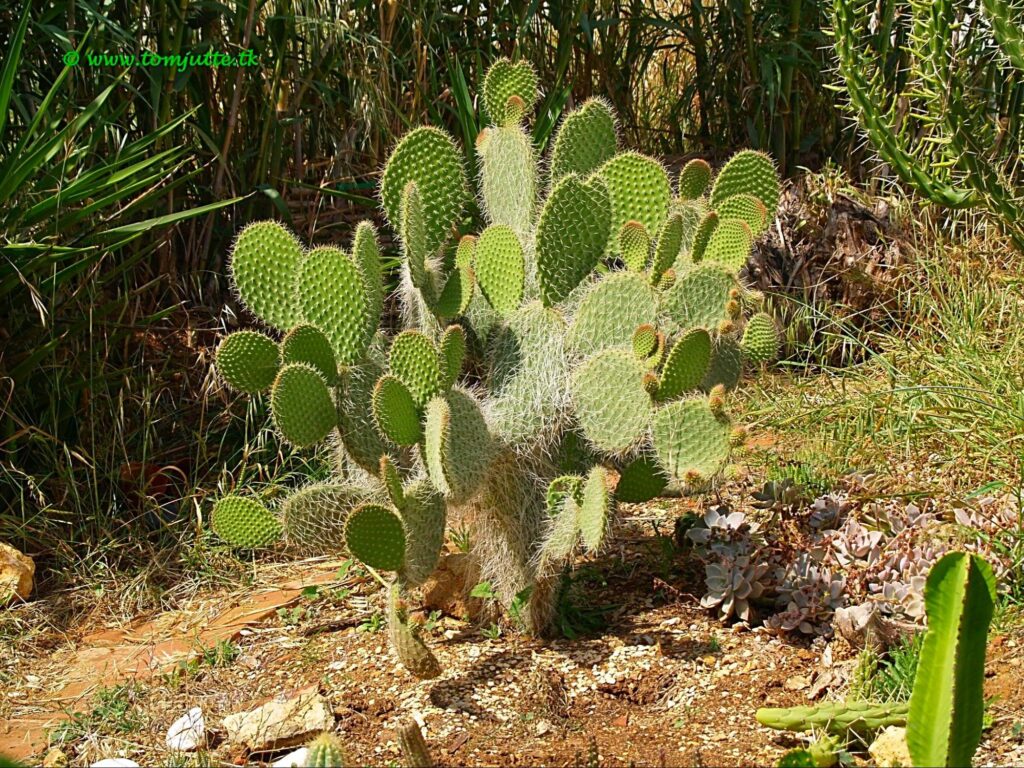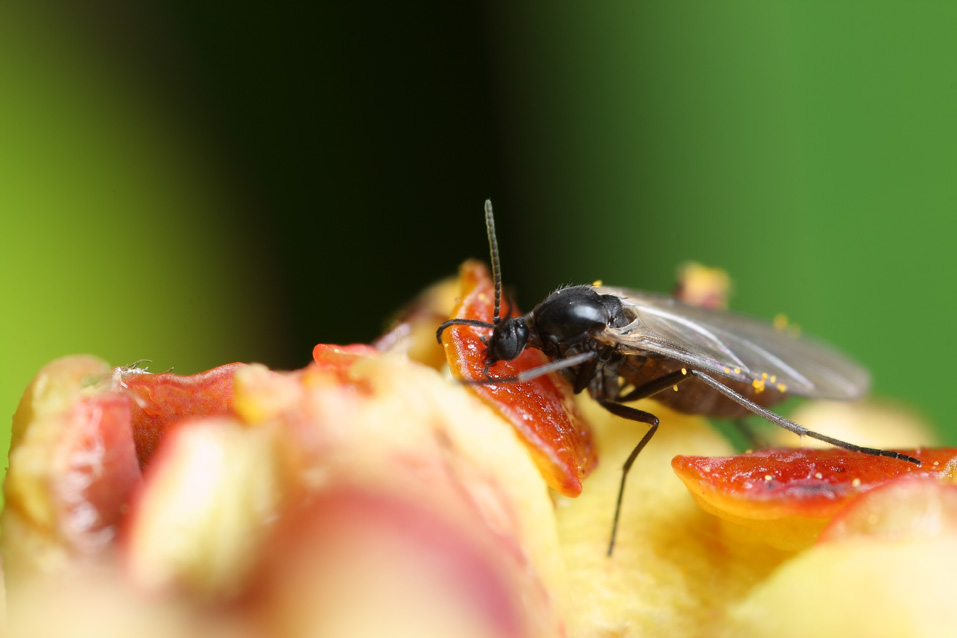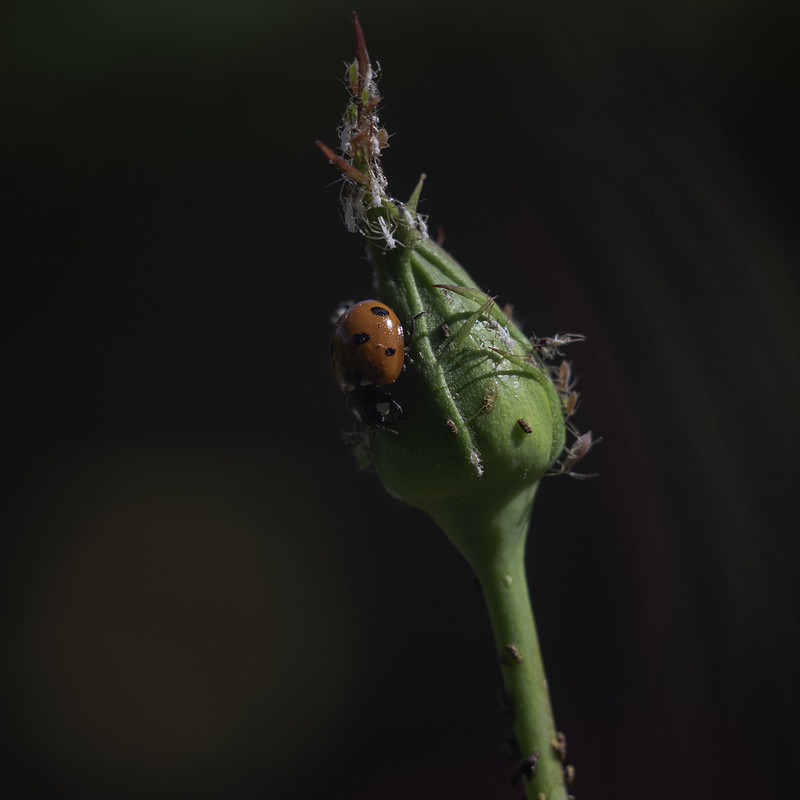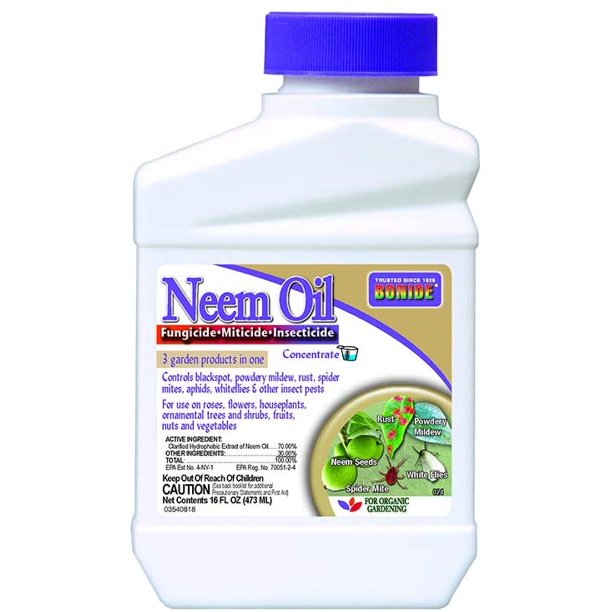Cactus (plural cacti) are beautiful perennial succulent plants in the family Cactaceae. The family comprises almost 139 genera with around 2000 species of flowering plants originating from North and South America. Cacti have thick chlorophyll-containing herbaceous or woody stems with cushion-like structures and trichomes. In this article, let’s look at gnats cacti.

Outdoor cacti garden
Cacti, throughout their life, prefer a dry climate to thrive and bloom in the growing season. However, when growing, cacti need consistently high humidity with regular watering. Such conditions attract moisture-loving insects—fungus gnats or gnats cacti.
Fungus gnats fly to cacti in moisture-rich conditions and high heat. The female lays eggs in the potting soil; within days, fungus gnats on succulents become a nuisance.
Fungus gnat infestations on cacti feed on the fungus (which grows in soil or on plants during high moisture contents) and the organic range of the potting soil mix. Under suitable growing conditions, fungus gnats will reproduce rapidly and may spread over other plants. However, their treatment is accessible at the early infestation stages through reproduction cycle interference with the help of yellow sticky traps. Moreover, hydrogen peroxide and diatomaceous earth also effectively control fungus gnat larvae.
What Are Gnats Cacti?
Fungus gnats or sciarid flies are small mosquito-like insects that feed on fungi and decaying plant matter. They have long antennas (extending over their head), tender legs, and dark wings. Many consider the adult fungus gnats harmless, but their presence indoors makes noise. Or the female lays eggs in between leaves, stem crevices, and potting soil.

Dark winged fungus gnat on flower
Life Cycle Of Fungus Gnats
Female fungus gnats lay eggs in the potting mix of potted plants, and within four days, the egg hatches to larvae. The fungus gnat larvae are 1/4 inches long, narrow, transparent, and have pale yellow bodies with blackheads.
Larvae aggressively feed on the algae and root hairs of affected plants. They feed in large groups and provide inside of the roots. In heavy populations, the larvae bore into the roots and stems that are in the soil.
These larvae also eat the leaves touching the ground. Within 21 days, the fungus gnats on succulents complete their life cycle from eggs to adults.

A large group of fungus gnat larvae
RELATED: Fishbone Cactus: The Only Care, Propagation, and Watering Guide You Need
Damage Caused By Fungus Gnat Larvae
The fungus gnat infestation on cactus feeds on the fungus that grows on them and moist soil. This is because the humid rich indoor environment favors fungus development and fungus gnat’s larvae feed indirectly.
Fungus gnats larvae expose the succulent plant roots to secondary pathogens (soil-dwelling fungal and bacterial spores). Due to root feeding, the aboveground plant parts start wilting. While in garden soils, they also spread to the other healthy plants, bore into their roots, and spread fungal pathogens.
One of the characteristic symptoms of fungus gnats infestation is root rot due to overwatering of cactus during early growth stages.
Fungus Gnats On Succulents (Home Infestations)
Cacti survive in their natural habitat in warm, hot, and dry climates. Therefore, in the winter months, bringing cacti indoors could save them from cold temperatures (a smart move). When you get your cacti indoors, check the plants thoroughly for fungus gnats and other pests.
Outdoors fungus gnats become more unpleasant if there are more indoor plants to support and provide them with more breeding sites. So, treating the cacti with organic pesticides is best before bringing them indoors.
How To Get Rid Of Fungus Gnats From Your Cacti?
Adult fungus gnat flies are unpleasant creatures that infest and breed in your plants. These succulent pests lay eggs in their potting mix and lead to the foundations of severe damage. Therefore, an early management strategy would prevent fungus gnats on succulents and their casualties.
The following are the best tips to avoid gnats on succulents:
- Before applying any treatment to your cacti, first, detect the root cause of the problem—is it biotic or abiotic?
- Identify fungus gnats on succulents because the adults may look like fruit flies.
- Remove the stressed plant from your indoor houseplant collection because these plants are more vulnerable to attack.
- Always remember that not all insects are harmful, and tolerate the presence of beneficial insects in your home and gardens. Unfortunately, these natural predators will feast on nasty succulent bugs.
- Destroy gnat eggs by mixing the cinnamon powder with potting soil mix.
- Use natural methods to destroy the pests, such as hand picking and washing off with the garden hose.
- Allow the soil to dry between each watering because dry soil discourages the female gnats from laying eggs.
- Try to kill the insects at their critical stages, such as destroying their eggs or interfering with their life cycle using gnat traps.
- Maintain proper indoor and outdoor plant hygiene (remove the algal scum and moist soil). Avoid overwatered conditions and remove extra compost and organic matter from your potted plants.
- Always sterilize the commercially available peat sources (because they may be infested with fungus gnats’ eggs and fungi spores).
RELATED: Growing Tips and Facts About Jumping Cholla Cactus, Desert’s Most Mesmerizing Plant
Use Biological Control To Get Rid Of Fungus Gnats On Succulents
The soil’s moisture contributes to fungus gnats infestation indoors and outdoors. However, in gardens, they are easy to manage with their natural enemies. Similarly, the fungus gnats can be controlled indoors by introducing lady beetles, green lacewings, mantis, and soil-dwelling predaceous mites.

Lady beetle (a gardener’s best friend)—the natural enemy of most garden insect pests
Use Dish Soap Spray To Kill Fungus Gnats On Succulents
Liquid dish soap spray prevents the infestations of fungus gnats on succulents and maintains their cosmetic value. To prepare the soapy water spray:
- Mix one part of the liquid soap per five parts of water and pour into a spray bottle.
- Spray over indoor cactus every week with regular monitoring.
Neem Oil Spray To Kill Fungus Gnats On Succulents
Neem oil is a triple-action product with the best results against fungal pathogens, spider mites, and other insects. Its applications (half the dilutions from the recommendations) will keep the succulent plants safe and healthy. To prepare the neem oil dilution:

Neem oil effectively kills whiteflies, fungus gnats, and other succulent bugs.
- Mix one teaspoon of neem oil per liter of water. Add one tablespoon of dish soap to emulsify the mixture.
- Pour the neem oil solution into a spray bottle and spray on your plant to kill and repel the fungus gnats.
- Be sure to apply on the soil near the plant base to destroy the eggs and larvae.
Use Yellow Sticky Traps
Place sticky and other gnat traps to identify and capture the adult fungus gnat populations. Also, use potato cubes to monitor the larval populations. The early detection of fungus gnat populations helps in the selection of effective management strategies.
RELATED: Ten Extraordinary Types of Tall Cactus Can Revive Your Yards and Landscapes
Use Diatomaceous Earth To Kill Fungus Gnats On Succulents
Keep the soil dry of your succulent plant to ward off the gnat flies, but the cacti need consistently wet soil during germination, attracting the fruit flies and gnats. Therefore, to discourage the gnats egg laying process, spread diatomaceous earth or diatomite.

Diatomaceous earth keeps the fungus gnat’s larval stages under control
The sharp edges of diatomaceous earth crystals pierce the larvae and kill them due to dehydration. Remember to reapply the diatomite after watering and rain.
Frequently Asked Questions
Is Hydrogen Peroxide Safe For Succulents?
Hydrogen peroxide solution will work great on succulents, like other plants, when used in dilutions. First, mix a few drops per cup of water to benefit from the hydrogen peroxide. Then, pour directly onto your plant’s roots to kill root rot and other disease-causing bacteria.
While its use as a soil drench will benefit the plant in terms of growth and development and kill the eggs and larvae of insects.
How Do I Get Rid Of Gnats In Potted Soil?
There are three ways to get rid of fungus gnats on succulents and potting soil:
- Using neem oil or granular insect killer as a soil drench
- Repotting
- White vinegar trap
When preparing the potting soil of your cactus, mix neem oil diluted solution with soil to kill eggs of fungus gnats at the first stage. If you have applied the neem oil drench, your cactus still appears yellow and weak (the reason is root rot). Then repot the plant into fresh potting, well-draining soil, and pot. Cut off the brown and damaged root when repotting the plant.
The third and most effective is using a white vinegar trap. Pour a few drops of dish soap and two cups of white vinegar into a bowl. Place the bowl near cactus plants, and the gnat flies will attract the smell of vinegar and fall into the trap.
Does Bottom Watering Prevent Gnats?
Bottom watering effectively prevents gnats because it reduces the moisture content at the soil’s surface. Fungus gnats thrive and survive in moist soil and damp organic matter. Hence, this technique of watering will eliminate the gnats.
Bottom watering involves placing a water filled tray up to 1 to 2 inches at the bottom of the pot. The water is then absorbed into the soil from the bottom up, allowing the roots to absorb enough moisture and draining the excess water, thus keeping the ground well aerated.
Do Fungus Gnats Indicate Root Rot?
If you plant your houseplants in the wrong soil (already infested with gnat eggs), your plants will experience root rot. Eggs hatch into larvae that aggressively feed on the root system of succulents and even feed inside the roots and letting the fungal pathogen invasion.
The damp conditions, overwatering, and gnat problem together leads to root rot and the killing of succulents.
What Is The Best Gnat Killer?
The best gnat killer is a white vinegar trap. It consists of dish soap, white vinegar, and one or two tablespoons of sugar (mix all the ingredients in a bowl and place them near your houseplants). The pungent smell of vinegar will attract the adult gnat flies and kills them. This technique is cost-effective with the best results.
Can You Spray Hydrogen Peroxide On The Cactus?
The diluted hydrogen peroxide solution (3 percent hydrogen peroxide is best) does not harm the cactus, and you can spray it on your plant for various purposes. Such as:
- To boost the oxygen levels of your growing succulents.
- To treat the root rot.
- Improves the soil and plant health by killing the soil-living organisms.
- It keeps the pests from your succulents and fertilizes them by improving soil nutrient levels.
Does Overwatering Cause Gnats?
Fungus gnats thrive in damp or overly wet soil, so overwatering your succulents will undoubtedly attract the gnat flies. In addition, the standing water conditions will provide them safe places for egg laying and cause root rot by blocking the oxygen supply.
Do Coffee Grounds Repel Fungus Gnats?
Coffee grounds do not repel fungus gnat infestation. Instead, it supports their growth by providing moisture and organic matter-rich soils. So, adding coffee grounds to the soil of your succulents will make things worse.
Do Cacti Like To Be Misted?
Cacti are native to warm climates and do not like water misting because these dry land plants harvest their moisture through intense and more profound root systems. So, misting with water will lead to a weaker root system. Instead, water their soil through the bottom watering to keep the soil surface dry and well aerated.
Sources For Further Reading
- Lang, K. (2021, December). A Cactus for Every Holiday: Caring for This Popular Indoor Plant. SDSU Extension. Retrieved August 1, 2022, from https://extension.sdstate.edu/cactus-every-holiday-caring-popular-indoor-plant
- Bethke, J. A., & Wilen, C. A. (2009). Fungus Gnats. UC IPM Pest Management Guidelines: Floriculture and Ornamental Nurseries. Retrieved July 31, 2022, from https://www2.ipm.ucanr.edu/agriculture/floriculture-and-ornamental-nurseries/Fungus-Gnats/
- Boyle, T. H. (2016, October 26). Commercial Producton of Holiday Cacti. Center for Agriculture, Food, and the Environment. Retrieved July 31, 2022, from https://ag.umass.edu/greenhouse-floriculture/fact-sheets/commercial-producton-of-holiday-cacti
Editor’s Recommendations
How to Effectively Control Houseplant Pests?
Common Types of Houseplant Bugs: Who They are & How to Get Rid of Them?







